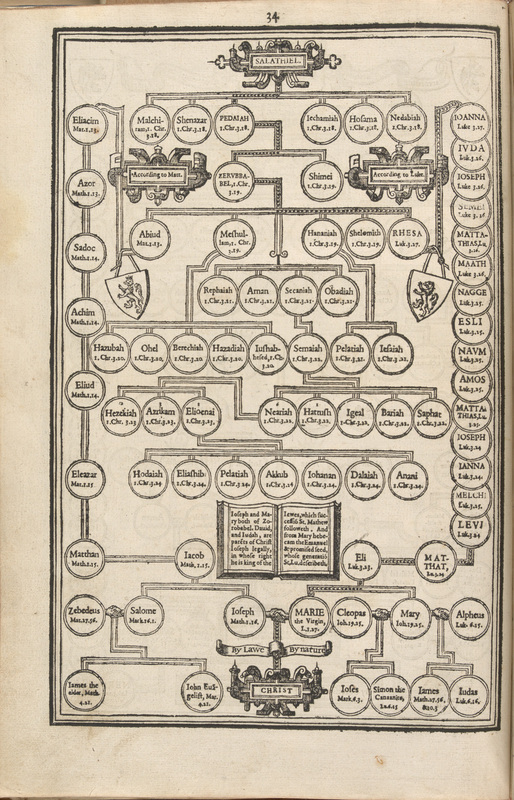The more I study Matthew’s genealogy, the more impressed I am by its content and construction.
What follows can probably best be described as καινὰ καὶ παλαιά = ‘things new and old’.
Hopefully it’ll be of use to someone.
Consider, for instance, how it’s patterned around the number 14:
🔹 It consists of 3 groups of 14 generations.
🔹 It lists David—who introduces a line of 14 kings—as its 14th member.
Even the number of times Matthew employs the name ‘David’ is significant.
No less significant is the number 42.
🔹 Its most frequently repeated word is τον, which occurs a total of 42 times and has a gematrial value of 420.
since the words ואלה תולדת/תלדות = ‘Now these are the generations’ (cp. Gen. 11.27, 25.19, 37.2 etc.) resonate strongly with the number 42 insofar as 42 = ואלה and 420 = תולדת/תלדות.
Matthew does not portray Jesus as an otherworldly deliverer who materialises out of thin air,
but as the summary and fulfilment of Israel’s history—the culmination of Abraham’s ‘generations’ (תולדת),
and the one who will release Israel from bondage and usher in a new phase in her history (יובל).
——————
But Matthew’s genealogy is not merely an exercise in numerology; it also serves to associate Jesus with a specific shape.
Insofar as Matthew’s genealogy moves forward in groups of 14, it resembles the course of the moon.
Or, more specifically, it begins with YHWH’s *promise* to Abraham, which finds its initial fulfilment in the rise of king David.
that is to say, we expect Israel to continue on an upwards path.
But instead, with the mention of Uriah’s wife and Rehoboam,...
And there Israel remain until, with the birth/adoption of Shealtiel—the man who undoes Jehoiachin’s curse—, a corner is turned in Israel’s history.
Like ‘Judah and his brothers’ (1.2), Jesus will soon be relocated to Egypt (2.13),
and, at the climax of his ministry, Jesus will be borne away into ‘an exile of death’.
Just as Jehoiachin’s exile spares him from Nebuchadnezzar’s fury, so Jesus’ exile to Egypt will spare him from Herod’s.
Like Shealtiel, then, Jesus will breathe new life into his people’s future.
As can be seen, then, Matthew’s genealogy is not a literary abstraction;
Israel’s story unfolds in blocks of 14, each of which reaches a significant zenith/nadir in its 14th generation, the third of which is the birth of the Messiah.
As such, Jesus arrives right on cue.
they refer to the long and sin-stained history recorded in Matthew’s genealogy—a history marked out by compromised behaviour,
Jesus has come to deliver his people from precisely these issues.
Sin is part of Israel’s present experience because it is an integral part of her past.
——————
TEXTUAL FOUNDATIONS
But how authentic is the pattern portrayed in Matthew’s genealogy?
Is it grounded in historical/textual reality? Or is it merely a pattern of Matthew’s own creation?
The first leg of Matthew’s genealogy:
Matthew’s genealogy between Abraham and David clearly isn’t his own creation.
It’s taken straight from the text of the OT (cp. 1 Chr. 2.1–15 w. Ruth 4.18–22),
It’s difficult to say much about the final leg of Matthew’s genealogy since we know so little about the relevant historical period.
But it’s at least possible Jesus was listed as the 14th generation from the exile in genealogies (stored up in the Temple).
And 10 generations is clearly too few to take us from c. 450 BC to 70 AD.
And might a similarly selective genealogy have been available to Matthew, which he included (unedited) in his genealogy?
Finally, then, we come to Matthew’s record of Judah’s kings, which we’re able to cross-reference with a large amount of Scripture data (most notably the records of Kings and Chronicles).
On what basis, then, has Matthew abbreviated a list of 17 to 14?
The answer requires us to consider the specific details of these kings’ reign and their relation to the houses of Ahab and Jehu.
——————
With the rise of Ahab, a remarkable sequence of events begins to unfold in Israel’s history.
Assisted by Jezebel, Ahab ruthlessly enforces the worship of Baal in Israel (at the cost of YHWH’s prophets).
And, sadly, the judgment of Ahab spills over onto Judah,
and Judah’s king is said to ‘follow in the footsteps of Ahab’, the blame for which is laid squarely at the feet of Athaliah (cp. 21.6, 13, 22.2–3).
Jehu is commissioned by Elisha to bring an end to the house of Ahab and, by extension, to the worship of Baal (2 Kgs. 9.6–10 w. 10.28).
In one of the most bloody periods of Israel’s history, he slaughters every male in the house of Ahab (2 Kgs. 9–10) as well as Jehoram’s son (Ahaziah) and no small number of Judah’s nobility (2 Chr. 22).
And, four generations later, Jehu’s dynasty falls, at which point YHWH restates his authorisation of Jehu’s reign (cp. 2 Kgs. 15.12).
First, it corresponds to YHWH’s promise to visit the iniquity of the fathers on their children up until the fourth generation (Exod. 34.7).
Equally important for us to note is the extent of Jehu’s authority.
Jehu’s authority is not limited to the northern kingdom, but extends to all Israel,
As such, the reign of Jehu represents a highly unusual period in Judah’s history.
Matthew’s genealogy reflects the fulfilment of YHWH’s promise to preserve David’s line/authority in Judah.
Just as the names of three women (Tamar, Rahab, and Ruth) are included in the Messianic line due to their association with divinely-favoured Judahites,
Judah’s kings die more violent deaths.
And YHWH is said to be more ‘active’ in the deaths of Judah’s kings.
As such, the Chronicler deliberately disconnects the reigns of Azariah, Joash, and Amaziah from their peers’,
Whatever the exact reason may be, the reigns of Azariah, Joash, and Amaziah are not ‘preserved’ in Israel’s Chronicles in the same way as others.
——————
FURTHER IMPLICATIONS:
More, however, needs to be said about the present matter,
Insofar as he omits to mention Ahaziah, Joash, and Amaziah, Matthew (paradoxically) draws our attention to their reigns.
Now, why would Matthew do such a thing?
The answer involves the transition between Ahaziah and Joash’s reigns.
When Ahaziah accedes to the throne, Judah’s politics are in a state of flux.
Edom is on the rise, and Ahab’s son has declared war against the Syrians (2 Chr. 21–22).
But Ahaziah’s decision turns out to be a bad one. Less than a year later, Ahaziah is slain and dies without any sons old enough to succeed him (2 Chr. 22a).
But Athaliah claims the throne for herself and promptly sentences Ahaziah’s sons to death in a bid to secure her claim (2 Chr. 22b).
The king’s sister, however, takes Joash and hides him in the Temple until he is ready to accede to the throne himself, and the Messianic line is hence enabled to live on.
An Edomite in the ascendancy, a king in consort with his counsellors, and a child of royal stock in a potentially fatal situation?
It should do, since the events of Matthew 2 are predicated on a very similar situation.
Just as ‘the seed of the Jewish kingdom’ is a threat to Athaliah’s power, so Jesus is a threat to Herod’s.
Needless to say, the parallels between Jesus and Joash’s lives are no coincidence.
The same dark powers which incited Pharaoh against Israel and Athaliah against Judah will gather together against Jesus,
——————
FINAL REFLECTIONS:
The fourteen-fold pattern reflected in Matthew’s genealogy has significant implications,
The first leg of Matthew’s genealogy is taken straight from the text of the OT.
And if Matthew’s genealogy is able to withstand critical scrutiny when it describes the period of Israel’s history best known to us—i.e., the days of Judah’s kings—,
Rather, Matthew appears to have identified a pattern inherent in Israel’s history which points towards Jesus as the long-awaited fulfilment of Abraham’s promise.
THE END














